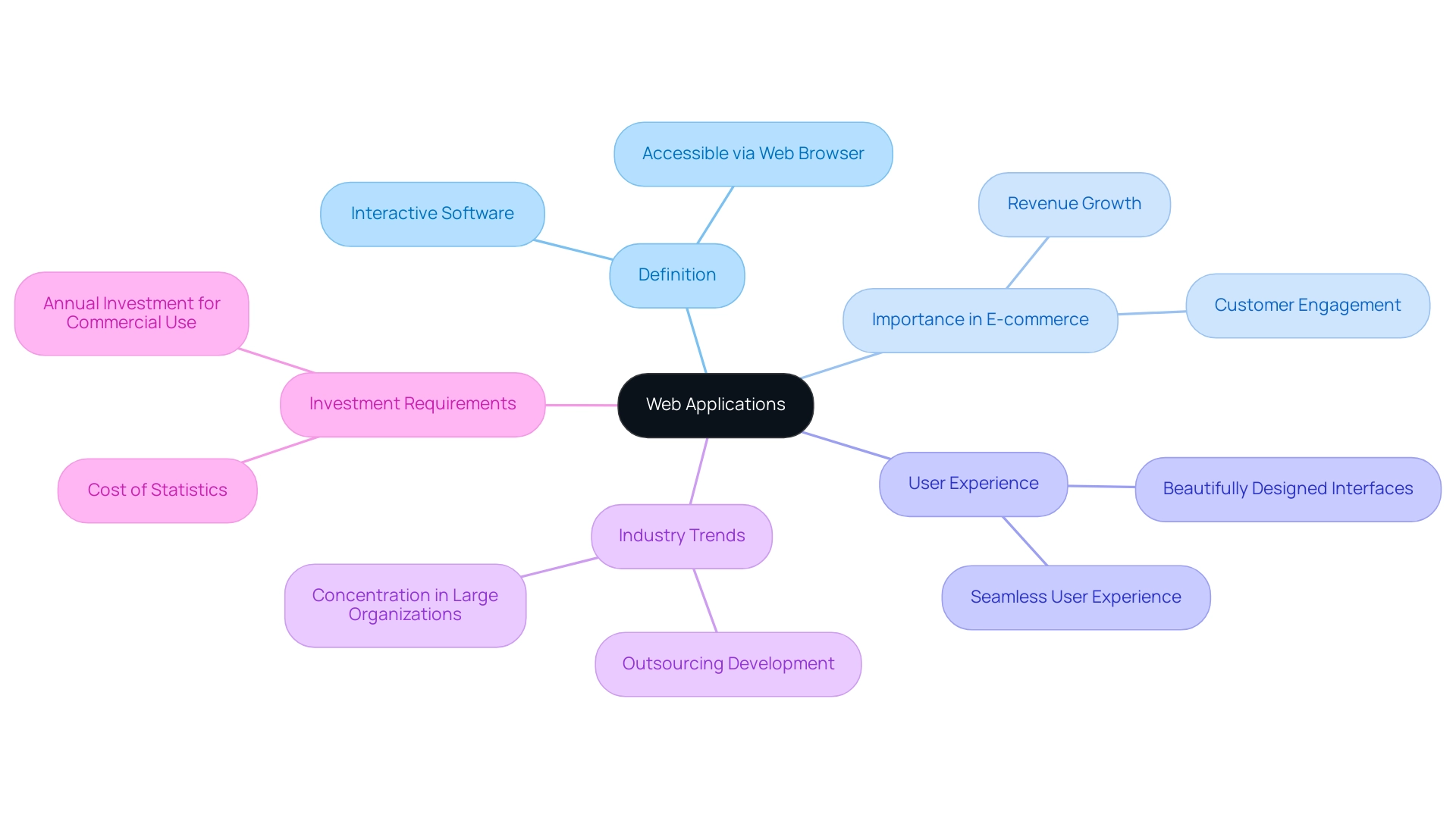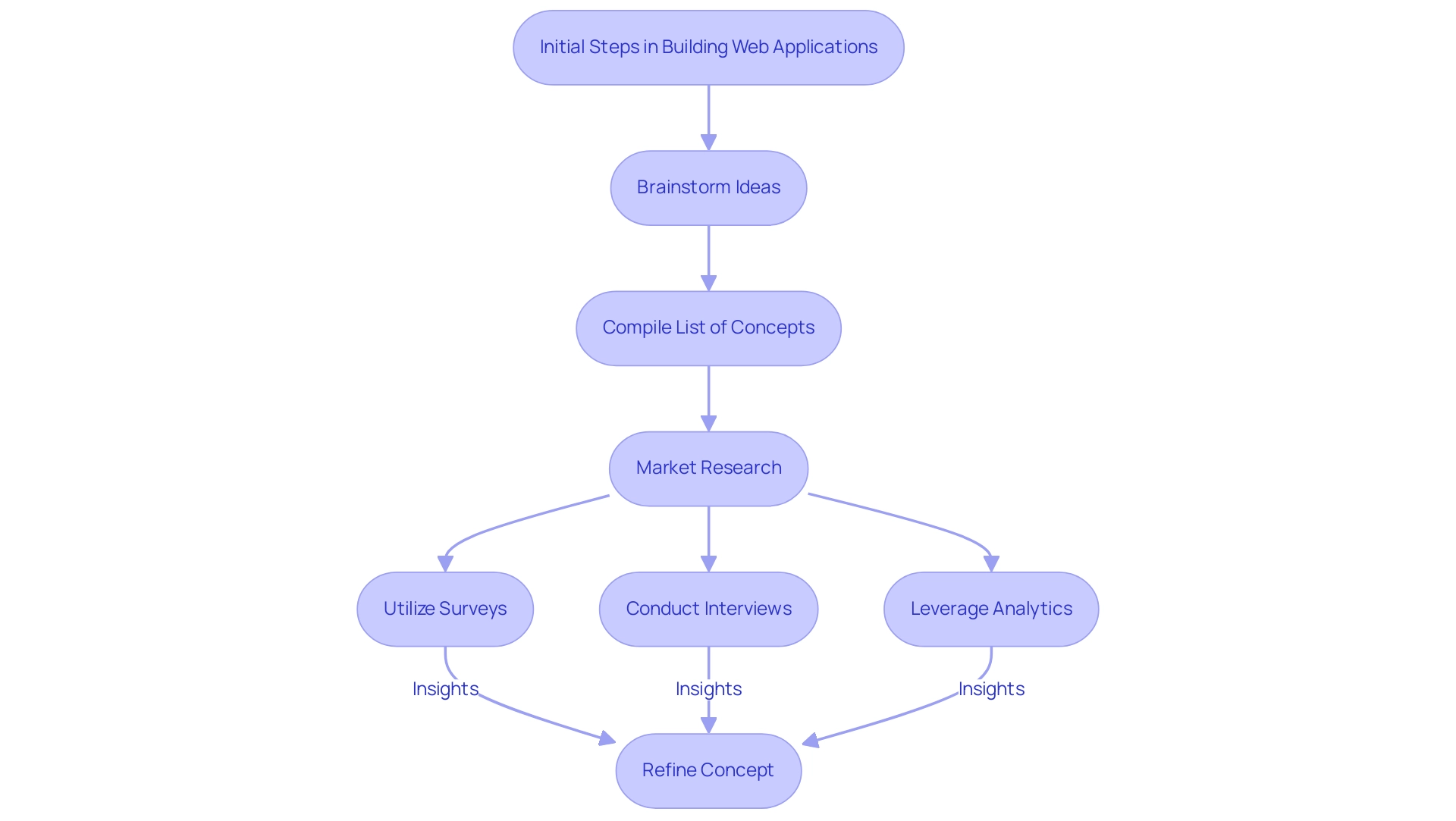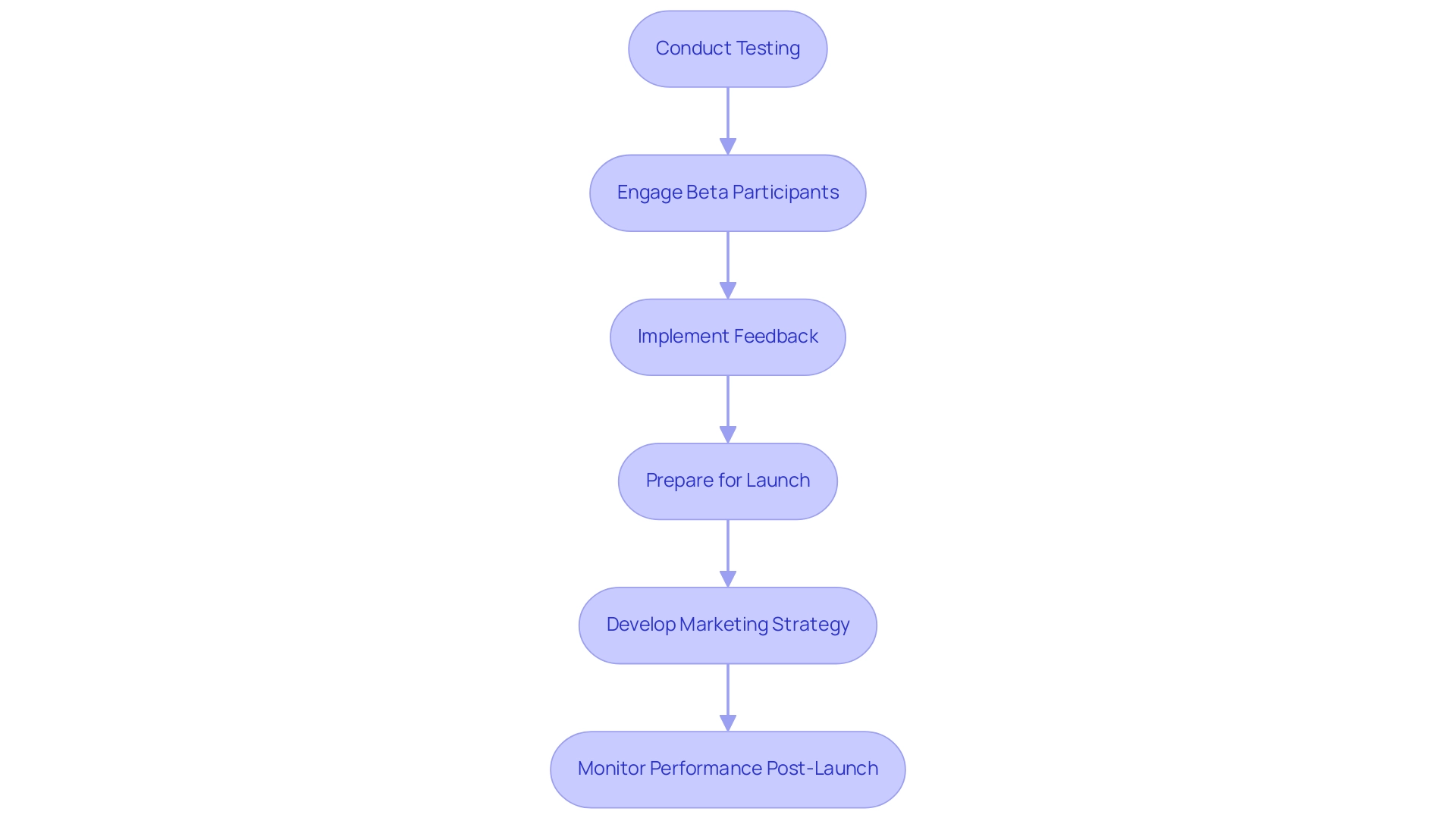Introduction
In the rapidly evolving digital landscape, web applications have emerged as indispensable tools that enhance user engagement and streamline business operations. As organizations pivot towards online solutions, understanding the nuances of web applications becomes crucial for success in 2024 and beyond. These interactive platforms not only offer the flexibility of access from any device but also empower businesses to respond to real-time data, ultimately driving revenue growth.
This article delves into the essential steps of creating a high-performance web application:
- Ideation
- Market research
- Design
- Development
- Testing
- Launch
By exploring best practices and insights from industry experts, businesses can navigate the complexities of web application development and position themselves for sustained success in an increasingly competitive market.
Understanding Web Applications: Definition and Importance
A web-based program acts as an interactive software solution reachable via a web browser, which can teach individuals how to build web applications while enabling them to accomplish specific tasks online. Unlike conventional desktop software, these web-based platforms demonstrate how to build web applications that can be utilized from any device with internet access, making them inherently versatile. The importance of online platforms in 2024 is highlighted by their ability to provide seamless user experiences, handle data in real-time, and expand market reach for businesses looking to learn how to build web applications.
In the realm of e-commerce, understanding how to build web applications is vital for enhancing customer engagement and streamlining operations, which are essential for driving revenue growth. With over 20 years of global experience across various sectors, our tailored e-commerce solutions have proven to significantly enhance critical KPIs, including retention rates and Average Order Value (AOV). We specialize in creating products that resonate with your community, aligning with internal goals and KPIs to build community value.
Nadica Naceva, Head of Content at Influencer Marketing Hub, emphasizes that her insights are supported by first-party data, ensuring that content meets the highest standards of relevance. With 59% of users favoring beautifully designed interfaces when engaging with content for just 15 minutes, investing in advanced web solutions is not merely a trend but a necessity for businesses aiming to thrive in the competitive e-commerce landscape. Furthermore, the transition from traditional software to web platforms reflects a broader industry shift, particularly in how to build web applications, as evidenced by the concentration of web development jobs in large organizations—47% of web development jobs in the US are in organizations with more than 10,000 employees, indicating a growing reliance on these technologies.
This trend suggests that smaller businesses may increasingly outsource their web development needs. Additionally, businesses looking to leverage web tools effectively should consider that access to relevant statistics starts at $2,388 USD yearly for commercial use, highlighting the investment required to stay competitive in this evolving market.

The Initial Steps: Ideation and Market Research
The first step in understanding how to build web applications is to brainstorm ideas that address specific problems or fulfill unmet needs. Once you’ve compiled a list of potential concepts, it’s crucial to dive into market research. This phase involves analyzing competitors and gaining a clear understanding of your target audience.
Effective strategies include:
- Utilizing surveys
- Conducting interviews
- Leveraging analytics to gather valuable insights into preferences and behaviors
As Adobe states, 'If given only 15 minutes to consume content, 59% would prefer to browse something beautifully designed,' highlighting the critical importance of a visually appealing interface. With more than 20 years of experience, we recognize that customized e-commerce strategies can greatly improve KPIs such as retention rates and Average Order Value (AOV), thereby creating community value and encouraging engagement.
Furthermore, these insights from market research directly guide the creation of our customized offerings, ensuring they align with expectations and enhance satisfaction. Our e-commerce solutions not only improve experiences but also create opportunities for incremental revenue generation for your organization. This context emphasizes the significance of refining your concept as a crucial step in understanding how to build web applications that ensure their viability and relevance in the current landscape.
By staying attuned to current market research trends and consumer preferences, you can develop a product that not only meets but exceeds expectations.

Designing and Developing Your Web Application: Key Phases
Begin the development of your web application by learning how to build web applications through creating wireframes, which serve as a vital tool for visualizing the layout and functionality. This initial step is essential for clarifying interactions and design elements, as '61% of all respondents spend more than 30 minutes a day searching for answers or solutions to problems,' emphasizing the need for intuitive designs. Following wireframing, proceed to develop a prototype to assess the experience and gather crucial feedback.
This iterative process illustrates how to build web applications by allowing for adjustments based on user interactions before final implementation.
Selecting the right technology stack is fundamental to understanding how to build web applications successfully. With the appropriate tech stack and a talented team, innovative software developments can be created, demonstrating how to build web applications to tackle business challenges. Consider critical factors such as scalability, security, and maintainability when making your choice.
Current popular stacks, such as MEAN (MongoDB, Express.js, Angular, Node.js) and LAMP (Linux, Apache, MySQL, PHP), are essential when learning how to build web applications, as each offers unique advantages suited for various software needs. For example, adopting a Serverless Stack can help developers concentrate on code without managing infrastructure, offering a cost-effective and scalable solution that automatically adjusts resources based on traffic demands. Working closely with designers and developers guarantees that your software not only captivates individuals visually but is also robust from a technical standpoint, thus aligning with the latest best practices in web design and development.

Testing and Launching: Ensuring Quality and Performance
Prior to launching your web application, it is essential to conduct thorough testing to identify bugs and confirm functionality. Implementing unit testing, integration testing, and acceptance testing will provide a solid foundation for your app’s reliability. Engaging beta participants during this phase is crucial; their feedback can highlight areas for improvement.
As noted by Martin Schneider, a Delivery Manager:
Before BrowserStack, it took eight test engineers a whole day to test. Now it takes an hour. We can release daily if we wanted to.
This reflects the efficiency gained through modern testing methods. Furthermore, investing in client experience is financially beneficial; every $1 invested in UX returns $100, equating to a staggering return of 9,900%. After comprehensive testing and necessary adjustments, it’s time to prepare for a successful launch.
A robust marketing strategy utilizing SEO, social media, and email marketing will effectively reach your target audience. As recent data indicates, about 70% of online shoppers read customer reviews before making purchases, emphasizing the importance of effective promotional strategies. This emphasizes how customer reviews and recommendations play a crucial role in influencing online shopping decisions, making feedback even more vital in the context of how to build web applications.
Post-launch, continuous monitoring of performance and user feedback is vital to ensure iterative improvements, fostering long-term success in an increasingly competitive digital landscape.

Conclusion
In the dynamic realm of digital solutions, the importance of web applications cannot be overstated. They serve as versatile platforms that enhance user engagement and streamline business operations, making them essential tools for organizations aiming for success in 2024 and beyond. From ideation and market research to design, development, testing, and launch, each phase of creating a high-performance web application plays a crucial role in ensuring that the end product not only meets but exceeds user expectations.
Understanding the nuances of web applications, including their design and functionality, is vital for businesses seeking to thrive in a competitive market. The emphasis on user experience, supported by data-driven insights, underscores the need for visually appealing and intuitive interfaces. Moreover, the integration of effective testing and robust marketing strategies is essential for launching a web application that resonates with the target audience and drives revenue growth.
Ultimately, navigating the complexities of web application development with a focus on best practices and expert insights positions businesses for sustained success. As the digital landscape continues to evolve, embracing these strategies will empower organizations to leverage web applications effectively, fostering innovation and maintaining a competitive edge in an increasingly interconnected world.





